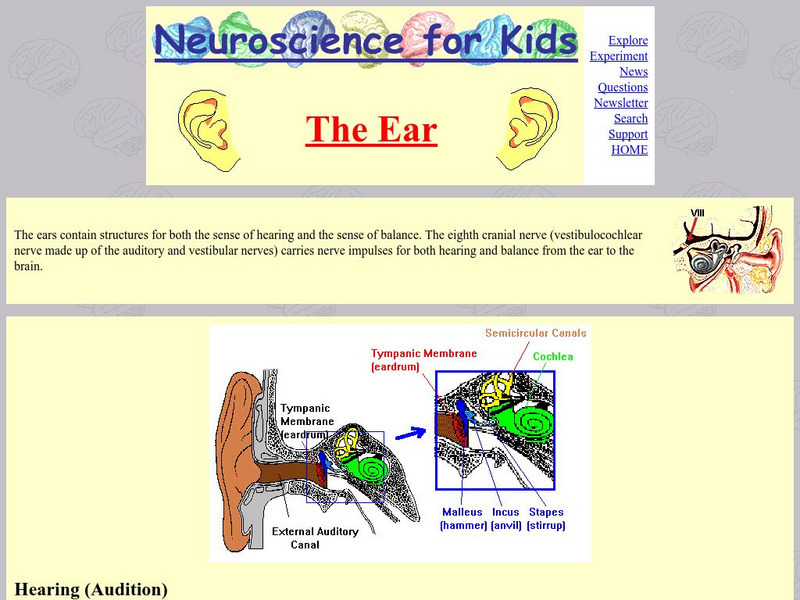Curated OER
A Black Box Problem: How Do I Hear?
High schoolers assemble a diagram of the hearing pathway using information about its parts and their function, and predict the changes in hearing that might result from specific changes to the pathway.
Curated OER
Bioglyphs
For this bioglyphs worksheet, students create a bioglyph diagram for themselves using the provided symbols for distinguishing characteristics. An example is provided.
Curated OER
Atmosphere Molecules
Students use foam packing pieces to represent molecular positioning inside the four layers of earth's atmosphere. This lesson help students visualize that molecules become thinner as one ascends higher in the atmosphere.
Curated OER
Mississippian Gardens
Students research and plan a Mississippian garden. In this Native American history instructional activity, students work in groups to research crops used by Native Americans in the Mississippian Period and use the information to...
Curated OER
HUMPBACK WHALES
Students identify the exterior body parts of the Humpback Whale. They draw it and correctly label the exterior body parts of the whale on their drawing.
Curated OER
Hearing
Students explore how the sense of hearing helps us learn from each other through communication. Sound can produce patterns.
Curated OER
Wonderful Worms
Students identify living and non-living things and explain the importance of earthworms to the soil. They name some basic facts about earthworms, recognize basic worm vocabulary words and demonstrate vermicomposting techniques.
Curated OER
Embryology Word Search Puzzle
In this biology word search worksheet, students search for 36 terms related to embryology. They check off the words as they find them in the puzzle.
Curated OER
Beautiful Bovine
Students compare and contrast a human body to a cow. Using a diagram, they label and identify the functions of the cow's numerous parts. In groups, they create a Venn Diagram to compare the various types of cows with one another. They...
Curated OER
Science Trail
Students take a trip on a science trail to explore how corn and soybeans can be made into fuel. They make a list of byproducts that come from soybeans. Afterward, they participate in the activities related to the creation of ethanol such...
Curated OER
Using My Senses
Students observe crickets in the terrarium. Have them record in their journal any evidence of crickets having senses. Then they answer questions like these: How do they use their sense organs? Where are they are located?
Curated OER
Corn in Legend and Myth
Seventh graders compare myths and legends about corn and use creative abilities to act them out. In this corn legends lesson, 7th graders read background information about corn and its importance. Students work in groups to research...
Curated OER
Regional Differences
Students examine how the brain sends and receives messages by assessing PET scans. They diagram areas of the brain that evaluate various situations. They discover that individuality is due to different responsesnin the brain.
Curated OER
Photoelectric Devices
Fourth graders view a teacher-made PowerPoint presentation on how photoelectric devices work, and then they answer FCAT-like questions on the material presented. They answer questions about what they viewed in an assignment imbedded in...
Curated OER
Tube Construction
Students are encouraged to recycle. They are provided the opportunity to construct a paper sculpture in the round. Students apply recycled products to create their sculpture. They share their creations with the class.
Curated OER
Owl Pellets: A Fowl-Up, Chuck!
Students discover the world of owls as predators. After watching a video of owls hunting and eating, are introduced to owl pellets. Students dissect their own pellet and match the prey's bones to a bone diagram.
Curated OER
Term Paths
Students follow several pathways using anatomical directions on a simulated "body" produced from a copy of a school building's fire evacuation plan.
Curated OER
Bat Ecology
Students, through hands on games and activities, discover how bats live and how bats benefit ecosystems. They play a game designed to show them how echolocation works and another to show how mother bats locate their young through their...
Curated OER
Make Sense of Nature
Students participate in this program that heightens their awareness and curiosity of nature as well as their sense of adventure and exploring new surroundings. They identify and choose an object from nature after exploring it with other...
Curated OER
Kids Health: Let's Hear It for the Ear!
Use this site to learn about the body part that is responsible for collecting sounds, processing them and sending them to your brain. See all the inner workings of the ear through great diagrams. Available in Spanish.
University of Washington
University of Washington: The Ear
The University of Washington offers a description of how the ear works, plus plenty of fascinating facts. Includes labeled diagram of the ear, sound clips of vocabulary words, and links to pages for further investigation.
Physics Classroom
The Physics Classroom: Sound Waves and Music: The Human Ear
Using diagrams and animations, students discover how the anatomy of the ear and the physics of sound waves work together to allow us to hear.
Merriam-Webster
Merriam Webster: Dictionary Illustration: Ear
Labeled diagram of the anatomical parts of the ear.
Other
Mindspring: Another Ear Infection?
Discusses the location and function of the eustachian tube, which is a key factor in middle ear infections. Includes a diagram of the ear.























